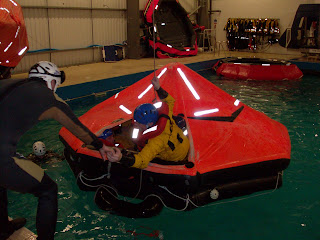
 So... Here we go... VISA applied for Cape Verde Islands off of West Africa for a transocean transition to the Falkland Islands... This should be awesome... crossing the equator and going to the end of the world!!! WooHoo!!! No need for bulletproof vests this trip, cause I don't think the Penguins are packing heat. We were going to crew change out of Chili but the Argentine Government said we would be crossing into their waters and since we will be working off of the Falklands (Think 1982, Margaret Thatcher and Great Britain) they would seize our vessel and arrest the crew. SO first change is as the boat heads south from the North Sea and the rest will be on god knows what into Port Stanley, Falklands.
So... Here we go... VISA applied for Cape Verde Islands off of West Africa for a transocean transition to the Falkland Islands... This should be awesome... crossing the equator and going to the end of the world!!! WooHoo!!! No need for bulletproof vests this trip, cause I don't think the Penguins are packing heat. We were going to crew change out of Chili but the Argentine Government said we would be crossing into their waters and since we will be working off of the Falklands (Think 1982, Margaret Thatcher and Great Britain) they would seize our vessel and arrest the crew. SO first change is as the boat heads south from the North Sea and the rest will be on god knows what into Port Stanley, Falklands.The Cape Verde chain lies in the North Atlantic Ocean, some 800 km (500 mi) from the coast of Senegal, Africa.
Cape Verde is also the birthplace of many of the significant hurricanes to travel across the Atlantic each year and make landfall in North America.

A Cape Verde-type hurricane is an Atlantic hurricane that develops near the Cape Verde islands, off the west coast of Africa. The average hurricane season has about two Cape Verde-type hurricanes, which are usually the largest and most intense storms of the season because they often have plenty of warm open ocean over which to develop before encountering land. The five largest Atlantic tropical cyclones on record have been Cape Verde-type hurricanes. Some of the longest-lived tropical cyclones in the Atlantic basin are Cape Verde hurricanes. While many move harmlessly out to sea, some move across the Caribbean sea and Gulf of Mexico, becoming damaging storms for Caribbean nations, Mexico, Bermuda, the United States, and occasionally even Canada. Research projects since the 1970s have been launched to understand the formation of these storms.
References
1. Chris Landsea (1997-07-18). "FAQ: HURRICANES, TYPHOONS AND TROPICAL CYCLONES (Part 1 of 2) Subject: A2) What are "Cape Verde"-type hurricanes?". Faqs.org. http://www.faqs.org/faqs/meteorology/storms-faq/part1/. Retrieved 2009-10-08.
2. National Hurricane Center (2009). "Atlantic hurricane database". National Oceanic and Atmospheric Administration. http://www.nhc.noaa.gov/tracks1851to2009_atl_reanal.txt. Retrieved 2009-10-08.
3. Colin J. McAdie, Christopher W. Landsea, Charles J. Neumann1, Joan E. David, Eric S. Blake, and Gregory R. Hammer (2009). Historical Climatology Series 6-2: Tropical Cyclones of the North Atlantic Ocean, 1851–2006 (with 2007 and 2008 track maps included). National Climatic Data Center. p. 161. http://www.nhc.noaa.gov/pdf/TC_Book_Atl_1851-2006_lowres.pdf. Retrieved 2009-10-08.
4. National Oceanic and Atmospheric Administration (2007-02-01). "Feature Stories : Fifty Years of NOAA Hurricane Research". Department of Commerce. http://celebrating200years.noaa.gov/magazine/50yrs_hurricane_res/image4.html. Retrieved 2010-01-20.
5. R. K. Kakar (Fall 2006). "NASA's Three Pronged Approach to Hurricane Research". National Oceanic and Atmospheric Administration. http://adsabs.harvard.edu/abs/2006AGUFM.A21H..01K. Retrieved 2010-01-20.
6. Jon Hamilton (2006-10-17). "Off Africa's Coast, a Hurricane Nursery". National Public Radio. http://www.npr.org/templates/story/story.php?storyId=6263948. Retrieved 2010-01-20.




